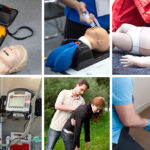What is a panic attack?
A panic attack happens when your body experiences a sudden intense fear where you feel like you are losing control. It triggers severe physical reactions such as a racing heart or chest pains when there is no real danger.
As a bystander or a first aider, you can save someone having a panic attack. If you wish to be the change, step forward and take a CPR training course from American CPR Care Association. Our courses are nationally accredited, and they adhere to the 2020 ECC Guidelines as well as the National Emergency Response Organization Standards.
What are the symptoms of a panic attack?
Panic attacks set off your nervous system which leads to the “fight or flight” response that usually occurs when you face a dangerous situation.
A panic attack can be a surprise as it can happen suddenly with no prior warning. The symptoms of a panic attack occur eventually and can heighten after about ten minutes. Below are the symptoms you should look out for:
- shortness of breath
- chest pains
- sweating
- stomach pain
- shaking or trembling profusely
- nausea
- rapid heartbeat
- hyperventilating
- feeling faint
- feeling of choking
- feeling numb
- struggling to breath
- struggling to swallow
- chills
- hot flashes
- feeling that death is approaching
- feeling of doom
How to help someone having a panic attack?
If you witness someone having a panic attack, you will also know that they can become anxious and have foggy thoughts. Here’s a list of a few things you can do to help them:
- Stay with the individual and help them remain calm.
- Move him/her to a quiet place.
- Ask the person if there is something they may need.
- Speak short sentences.
- Avoid surprises. Be obvious.
- Help the individual focus.
- Ask the individual to take up a short and simple task like raising his/her arms over their head.
- Do breathing exercises to help reduce stress. You can do this along with the person by slowly counting to 10.
- Reassuring a person suffering from panic attacks that you won’t leave would be helpful. You can remind them that the attack won’t last long. Assure them that they are safe by telling them.
- Validate their distress. Know what to say.
A few examples of things you can say to a person dealing with panic attacks are:
- “What do you need? Tell me, and I’ll get it for you.”
- “You’re doing a good job. I’m proud of you.”
- “You will get through this.”
- “Concentrate on your breathing. Do not think about anything else.”
- “What you are feeling is temporary. This too shall pass.”
How to prevent panic attacks?
While panic attacks are scary, they are not dangerous. They may be unpredictable, therefore, preventing them can be a challenge. Here are a few steps you have to take to maintain your well-being and reduce the risk of panic attacks.
- eat a well-balanced meal
- exercise regularly
- get enough quality sleep
- find ways to manage and reduce stress
Dealing with panic attacks is crucial. It is essential to ask for help when you think you need it. Consult a doctor if you experience panic attacks often. Get treatment to avoid more episodes of panic attacks in the future.
3-3-3 rule for panic attacks
Have you heard of the 3-3-3 rule for panic attacks? The rule states that if you have a panic attack, all you need to do is look around you, name three things you see, and three sounds you hear and move three parts of your body. You can move your arm, your ankle, or your fingers.
While there is no evidence of the effectiveness of this 3-3-3 rule, many people find this technique helpful in handling panic attacks. Sometimes, the trick is to slow down your brain from speeding at 100 miles per hour and bring you to the present.
Do I need to call an ambulance for a panic attack?
Dealing with panic attacks can be terrifying as they are not always easy to identify. People suffering from panic attacks are more often fearful of having a panic attack in public.
Most times, a person may feel they are experiencing a heart attack due to the significant distress caused. It can take time to differentiate between a panic attack or a heart attack.
If you are in doubt, call 9-1-1 immediately without further delay.
4 Ways to stop a panic attack
If you find yourself or a person breathing rapidly, here’s what you need to do:
- Ask the person to take deep breaths slowly and gently through the nose.
2. Slowly and gently breathe out through the mouth.
3. Close your eyes and focus on your breathing exercises.
4. Count steadily from one to five while taking each breath in and each breath out.
Conclusion
It is essential to learn how to provide life-saving assistance in an emergency. Sign up for the American CPR Care Association’s online CPR and First Aid certification course today to learn more about CPR and how to administer it properly. If you have any doubts, our team is happy to help you.







